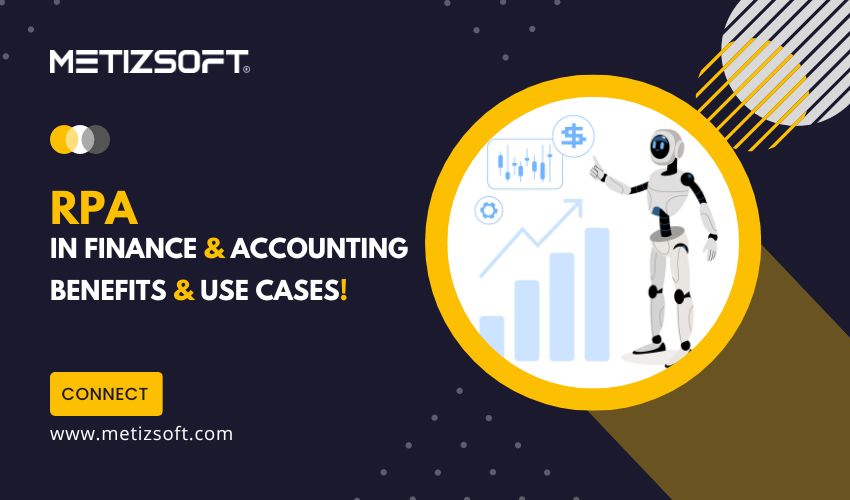
The rise in demand and supply has overburdened businesses with tedious and mundane tasks. One of the prime examples of this phenomenon is financial institutions.
The growth of digitalization has made financial institutions deal with extensive daily transactions, accounting, invoices, and report-making. This led to many difficulties in managing everything every day with sheer accuracy.
As a result, they opt for many advanced technological solutions until they find Robotic Process Automation, aka RPA. RPA for financial institutions came as a savior with immense capabilities. It has indeed transformed their accounting process, helping streamline the operations accurately.
In this blog, we will talk more about the role of RPA in finance and accounting. We will also highlight the benefits, use cases, and more for better understanding.
Table of Contents
The Role of RPA in Finance and Accounting!
RPA is software technology that programs robots to perform tasks previously done by humans. It utilizes software robots to automate tasks that emulate human actions within legacy systems and desktop applications.
Robotic Process Automation enables organizations to optimize financial processes and revolutionize accounting practices.
All those RPA applications are programmed to perform specific needs, from automating financial statement audits to accelerating accounts receivable and payable tasks.
The best thing is that you will see a quick return on investment (ROI) right after the implementation of robotic process automation in your existing finance system.
Real-time RPA use case example in Finance and Accounting
RPA’s staggering use cases in finance and accounting have increased recently. RPA implementation in this segment has resulted in cost savings, improved employee productivity, and efficient business processes.
Let’s explore some of the most frequent use cases of RPA in finance and accounting operations, considering the benefits of automation.
Quicker & Accurate Billing – Previously, finance and accounting operations were followed by traditional processes. Those traditional processes were tedious, repetitive, and rule-based, demanding high-end consistency and accuracy. Since RPA’s adoption, the table has turned for them. The involvement of bots has taken over mundane tasks, assuring quick and accurate efficiency.
Improved Fraud Detection – RPA implementation has made fraud detection easier. The frequency of fraud has dropped significantly in financial institutions. Additionally, RPA guarantees timely communication of relevant changes to stakeholders, reducing the risk of overlooking potential risks at the business or regulatory levels.
Finance Report Optimization – Financial reports are a game-changing perspective for any organization. One mistake in any numbers can lead to a hazardous situation, and the entire month/year budget can tremble.
It’s a crucial aspect that demands specialist attention, which consumes time, effort, and money. RPA is more than just a requirement for this segment. It eliminates human errors and ensures consistent and accurate data compilation.
Advanced Invoice Processing – Financial institutions deal with invoice management daily. Indeed, invoicing is a complex and time-consuming process that RPA can efficiently handle in finance. Specifically, it automates the processing of invoices, stores them, automates data input, reconciles errors, and minimizes the potential for human errors and the need for human intervention.
Payroll Management –One of the uses of robotic process automation (RPA) in the financial sector is employee payroll management. This is a time-consuming process involving several subtasks, such as:
- Data entry and extraction
- Timesheets validation
- Employee information verification
- Payments scheduling
- Payout calculation
RPA helps automate payroll management by extracting data from various sources and accurately calculating payments to prevent inaccuracies or delays.
Expense Reporting & Management – Expense reporting is vital to efficient bookkeeping and finance management. However, performing this task takes time and effort. Robust RPA bots can help automate the process by:
- Aggregating data into expense reports
- Attaching receipts to corresponding entries
- Verifying existing expense logs
- Flagging policy violations or data discrepancies.
Automating expense reporting with RPA reduces errors, improves employee experience,
and enhances policy compliance.
Benefits RPA brings to the Finance and Accounting
RPA offers numerous benefits for financial automation that enable CFOs and other financial experts to adapt and respond to the fluctuating economic environment.
Here is a look at some of the core benefits it brings to the table:
Time Efficiency – Finance and Accounting involve long strings of numbers and repetitive, rule-based transactional processes. Consequently, the implementation of RPA applications in accounting boosts operational efficiency. Ultimately, it allows employees to save hours on brainstorming or other revenue-generating activities.
Cost Saving – Budget optimization significantly benefits robotic process automation in finance. RPA can reduce labor costs by up to 40% and handle repetitive tasks more efficiently than humans.
Data Innovation – By intelligently combining legacy and new data, RPA provides deeper insights into business operations. Thus, this unique combination of data in a single system results in better reporting and insights, ultimately contributing to the growth of the business.
Existing System Integration – RPA is a newer technology that differs from traditional automation in finance and accounting. RPA’s ability to seamlessly interact with existing corporate systems sets it apart.
It can manipulate data, initiate responses, review reports, and tackle problems. Robots used in accounting have the same level of security and access as a real person, but can work without interruption.
Reduce Errors – Manual accounting procedures can be automated using RPA services to eliminate human errors, which can cause significant losses when they accumulate in each department.
Ensure seamless RPA implementation
RPA provides immediate ROI with out-of-the-box financial automation solutions. Hence, follow these easy steps to start your financial automation journey.
Enlist Tasks – Identify all the manual processes your employees spend time on. Make a list of all the repetitive, manual & high-volume functions based on their complexity.
Documentation – Note the improvements and the steps involved and the relevant parties. This documentation will help ensure everyone is on board when RPA is deployed.
Data Preparation – RPA relies on structured data for executable processes, so consolidating data at a centralized location streamlines processing.
Determine Process – Start by defining the process and its intended goal. Design the process by identifying stop goals and reviewing progress at each step.
Testing – Before implementing RPA on a large scale, starting with a small test may be beneficial to ensure that your objectives and processes align.
The process requires a lot of planning and execution. For the best and most seamless RPA integration, hire RPA experts from a recognized RPA service provider like Metizsoft Solutions. It will help you save time and effort while enabling the best possible results.
Final Thoughts!
RPA is revolutionizing Finance and Accounting by automating tedious tasks, improving accuracy and compliance, boosting efficiency, and enabling scalability. As a result, as RPA technology continues to evolve, its impact on the Finance and Accounting function will only grow, making it a crucial tool for businesses looking to gain a competitive edge.
Therefore, by understanding the role of RPA in Finance and Accounting and its potential benefits, institutions can make informed decisions about leveraging this technology to improve their accounting operations and achieve their financial goals.
AboutManthan Bhavsar
Related Posts
Top RPA Use Cases & Benefits in Retail Inventory Management
Managing retail inventory takes time and effort, regardless of size and capacity. It requires eagle-eye attention to data...
How RPA is Scaling up Finance and Accounting Processes!
The rise in demand and supply has overburdened businesses with tedious and mundane tasks. One of the prime examples of this...

